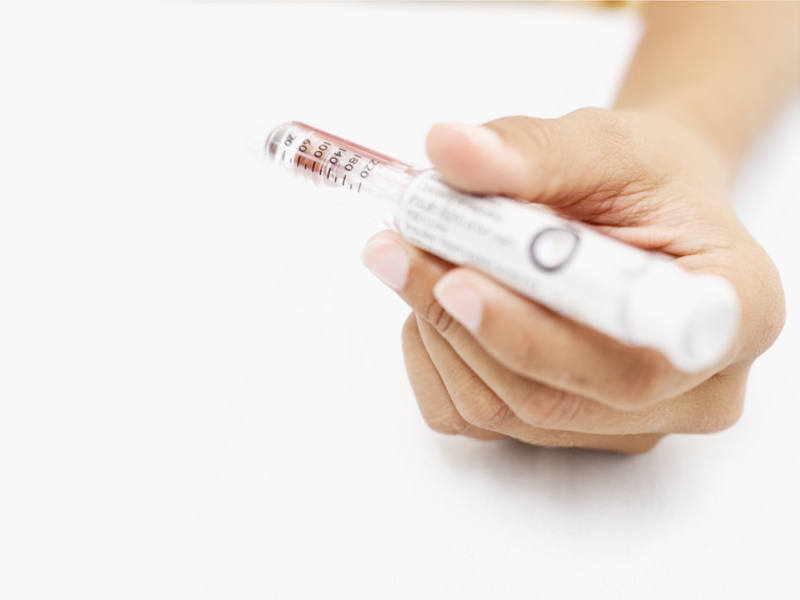Written by Dr. Gregory B. Hughes
The switch takes time and patience, but freedom and flexibility come with the pump.
If you or someone you know has diabetes, you understand just how much effort goes into managing blood sugar levels. The idea of using an insulin pump may be attractive because you imagine it will eliminate all of this work, but the reality is that insulin pumps require as much, if not more, attention and care compared with injections. However, for those who have made the switch, insulin pumps provide more freedom and flexibility.
How do they work?
An insulin pump combines an external device, about the size of a cell phone, and a small insulin infusion tube inserted under the skin. Insulin pumps mimic the pancreas by delivering short-acting insulin in very small amounts about every five minutes. They can provide the insulin the body needs when not eating, referred to as “basal insulin.” This constant release of insulin replaces the need for an injection of long-acting insulin.
A common misconception suggests that insulin pumps automatically know when and how much insulin to provide, eliminating the need for blood glucose testing. This is not the case. If you opt to use an insulin pump, your adjustments and pump settings are actually dependent on accurate blood glucose testing.
When you first begin using a pump, your physician will estimate your settings based on current daily insulin amounts and teach you how to check and verify these settings. You’ll need to frequently monitor your blood glucose levels throughout the first few weeks in order to adjust the pump. Once you arrive at the correct settings, you’re encouraged to check your blood glucose at least four times a day: before each meal and at bedtime.
At meal times, when you need more insulin to control blood glucose, the pump can deliver a higher, one-time dose of insulin. When properly set, the pump can help calculate this “bolus” insulin dose, but you must input accurate blood glucose levels before eating and how many carbohydrates you plan to consume.
Are they as effective as injections?
Assuming you’re using an insulin pump correctly, pumps can be more effective in certain situations than injections. All insulin pumps must receive approval from the Food and Drug Administration, which results in rigorous testing to examine virtually every possible risk associated with using these devices.
However, insulin pumps are only effective if you remember to test your blood glucose and receive insulin at the proper times. You must also adjust your insulin dose based on food intake. As with insulin injections, if you don’t receive the proper amount of insulin at a meal or if you forget to eat, you can experience harmful side effects, such as hyperglycemia (high blood glucose) or hypoglycemia (low blood glucose).
Insulin pumps work similar to the pancreas by releasing a steady stream of insulin into your body. Because pumps are programmable, insulin amounts and absorption rates can be adjusted at any time of the day or night, even while you are asleep.
One of the greatest benefits of using an insulin pump is having the freedom to decide when you eat. Because you “tell” the pump when and how much you are about to eat, you receive the right amount of insulin when you need it. You don’t have to be quite so strict about eating on schedule, but you do have to remember to input the information prior to your meals. And yes, all the same dietary rules for diabetics still apply.
Insulin pumps also allow you to adjust the amount of insulin you receive based on your activity level. If you know you’re going to exercise, you can temporarily reduce the infusion rate to avoid a dangerous drop in blood glucose. Not only does this advantage of insulin pumps decrease your chance of becoming hypoglycemic, it eliminates one more excuse for not exercising.
Are there any disadvantages?
Insulin pumps and related expenses are costly, so you’ll want to check with your physician and insurance company before making your decision. You must also be willing to spend the time and energy to learn how to use a pump properly. Insulin pumps require consistent monitoring and regular maintenance, like changing the infusion tubing every three days and changing the battery when low. It’s like learning to drive a car—you have to learn the rules, practice and demonstrate to others that you are able to manage on your own.
When helping patients decide if an insulin pump is right for them, I ask them to monitor their blood sugar and insulin injection amounts for a month. If a patient isn’t willing to do this, he or she is probably not a good candidate for an insulin pump. The patients that return with PowerPoint presentations chronicling their daily fluctuations in blood sugar are usually safe to make the switch.
Wearing an insulin pump 24 hours a day will take some adjustment, especially during sleeping and showering. Otherwise, no major lifestyle modifications are needed to use a pump.
Still on the fence? It may be helpful to know that insulin pumps don’t require a lifelong commitment—you can always switch back to insulin injections if you are unhappy with a pump. In fact, if there is ever a time users worry that their pump isn’t working properly or are unable to wear it, they can disconnect from the pump and return to insulin injections.
And, please, do learn more. The greatest advice I can give to a patient considering an insulin pump is to have realistic expectations about what a pump will and will not do for you. Whether you receive insulin from injections or an insulin pump, your health and well-being is ultimately in your hands.







